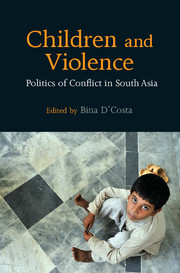Book contents
- Frontmatter
- Dedication
- Contents
- List of Map, Figures and Tables
- Acknowledgements
- Introduction: ‘Turtles Can Fly’: Vicarious Terror and the Child in South Asia
- Part I Shaping Childhood in South Asia
- Part II Conflict and Violent Peace
- 4 Migration, Mobilization, and Memory: The Sri Lankan Civil War in the Lives of Tamil Youth
- 5 Politics of the Orphans of War: 72 Children's Journey from the Chittagong Hill Tracts of Bangladesh to the Suburbs of France
- 6 Besieged Childhood and Broken Dreams: Failed Promises of the State and Maoist Movement in India
- 7 Impacts of Terrorism on Children in Pakistan: A Case Study of Displaced Children in Khyber Pakhtunkhwa
- Part III Rights, Needs and Protection
- Part IV Reflections from Human Rights Advocates in the Region
- Bibliography
- Notes on Contributors
- Index
7 - Impacts of Terrorism on Children in Pakistan: A Case Study of Displaced Children in Khyber Pakhtunkhwa
from Part II - Conflict and Violent Peace
Published online by Cambridge University Press: 05 June 2016
- Frontmatter
- Dedication
- Contents
- List of Map, Figures and Tables
- Acknowledgements
- Introduction: ‘Turtles Can Fly’: Vicarious Terror and the Child in South Asia
- Part I Shaping Childhood in South Asia
- Part II Conflict and Violent Peace
- 4 Migration, Mobilization, and Memory: The Sri Lankan Civil War in the Lives of Tamil Youth
- 5 Politics of the Orphans of War: 72 Children's Journey from the Chittagong Hill Tracts of Bangladesh to the Suburbs of France
- 6 Besieged Childhood and Broken Dreams: Failed Promises of the State and Maoist Movement in India
- 7 Impacts of Terrorism on Children in Pakistan: A Case Study of Displaced Children in Khyber Pakhtunkhwa
- Part III Rights, Needs and Protection
- Part IV Reflections from Human Rights Advocates in the Region
- Bibliography
- Notes on Contributors
- Index
Summary
Pakistan is home to thousands of internally displaced children (hereafter IDC) due to the prevalence of natural disasters and high rates of terrorism. The majority of internally displaced persons (IDPs) are uprooted from their homes due to reoccurring clashes between Pakistan's security forces and local Taliban militant groups in the province of Khyber Pakhtunkhwa (KP) and the tribal region. During the peak of violence in 2008–09, the level of conflict induced displacement reached the figure of three million in KP. For IDPs, the situation has been very destabilizing. While many did return to their homes, they were uprooted once again after the launch of operation ‘Zarb-e-Azb’ in June 2014.
While displacement affects everyone, women and children are the most vulnerable to health hazards, malnutrition, lack of physical security and psychological trauma. The destruction of homes, schools and other infrastructure (hospitals, electricity, roads etc.) similarly affects their lives and livelihoods in significant ways. Moreover, displaced children, who live in unprotected shelters or on the streets, are often at risk of being forced into child labour and early marriages.
The abovementioned issues are common impacts of displacement for IDCs from marginalized families with limited resources. Being victims of conflict, they also face trauma from direct exposure to bloodshed and human suffering. Displacement, with its much insecurity often serves to enhance these psychological issues. This chapter aims to draw lessons from the case of IDCs in KP by examining the circumstances under which displaced children are living. It is hoped that this analysis will help to bring much-needed attention towards addressing the particular issues faced by displaced children in Pakistan.
Children and Conflict
After the end of the Cold War, the severity of intrastate conflicts was brought to the fore of international affairs. Millions of people continue to suffer from intrastate violence, such as through civil wars, genocide, sectarianism, extremism, and terrorism. Among IDP populations, women and children arguably suffer the greatest due to their high levels of vulnerability.2 Children comprise half of the world's IDPs.
Armed conflicts have severe consequences for children, especially in cases where they directly experience violence. Thousands of children are killed as civilian victims of wars.
- Type
- Chapter
- Information
- Children and ViolencePolitics of Conflict in South Asia, pp. 182 - 196Publisher: Cambridge University PressPrint publication year: 2016



